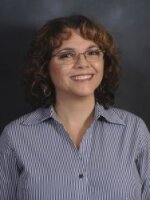One of the ways Pensacola’s cultural heritage is celebrated is through the individual people who lived here generations ago.
A recent event highlighted the city’s culinary history through the lives of four unique and diverse women who made Pensacola their home in the early 1800’s.
We’re getting to know Victoire Le Sassier, Marianna Bonifay, Dorothy Walton, and Genevieve Ham. Their stories were featured during the 2018 Pensacola Repast event held May 6, downtown.
Archaeologist Margo Stringfield, with the University of West Florida Archaeology Institute, is writing a book about Florida's historic cemeteries. She chose these women based on her extensive research at Pensacola’s Historic St. Michael’s Cemetery, where they’re all buried.
“Ah, the four ladies we picked to highlight represent the diversity that we see in Pensacola in a period of time that’s the dividing line between Spanish colonial and American territorial,” said Stringfield, who focused on the period between 1821 and 1830, when the city was becoming a true melting pot.
“You primarily had people from French and Spanish ethnicity; you also had people coming out of African and Afro-Caribbean. Then as we move toward 1821, we see people flowing into Florida to take advantage of what they’re seeing as the future of Florida, which is as an American territory.”
It was at this time, that the Anglo population of Spanish West Florida, which extended westward to Louisiana, began to grow, with the influx of people from British, Scottish, and Irish heritage moving in from the north.
One such individual was Dorothy Walton, born in Chatham County, Georgia in 1754.
“She holds a special place, I think, for Pensacola,” Stringfield said, noting that Dorothy Walton was married to George Walton, who was one of the signers of the Declaration of Independence. “She would have been an intimate observer of the formation of our country. She would have been entertaining men that were associates of her husband. She would have been hearing what they were saying and probably offered an opinion or two.”

According to Stringfield, Walton also was an intimate witness to the formation of the state of Florida, coming to Pensacola in 1821 and living with her son George Walton, Jr. and his family. “He had come into Pensacola as one of the first administrators of the territory, held high government positions, and was a crony of Andrew Jackson,” said Stringfield.
Walton died in Pensacola in 1832. Her grave, which is located in the old part of St. Michael’s Cemetery, features a flat slab of marble, enclosed by a brick wall, and marked with a bronze memorial plaque.
Victoire Le Sassier died a year later in 1833. She had lived in Pensacola since the early 1780s after Spanish General Bernardo de Galvez declared victory in the Battle of Pensacola.
“She was a French woman; her family was rooted in New Orleans,” Stringfield said. “She was a woman of means herself and she married Jose Noriega, and we’ll refer to him as senior, because her son was also Jose Noriega. But, her husband came to Pensacola with Galvez and he was part of Galvez’ force and he stayed on as a representative of the Spanish government for several years.”
Stringfield says Le Sassier represents both the French and Spanish traditions out of New Orleans that became entrenched in Pensacola. Le Sassier’s fascinating life included a later marriage to a man who tried to deprive her of her assets and unsuccessfully tried to poison her.
“We know a good bit about Madame Le Sassier, because there were court cases, there were wills,” said Stringfield of the wealth of historical documentation about Le Sassier. Her burial in St. Michael’s Cemetery has a beautiful marble, tablet marker that’s associated with her son.

Also highlighted and buried near Le Sassier is Marianna Bonifay. She was born about 1760 in France and died in Pensacola in 1829.
“Another strong woman, who was in business for herself, formed strong partnerships,” said Stringfield of Bonifay who came out of French tradition, through the Caribbean to New Orleans and then into Pensacola. “She left a strong tradition in our construction era. I think we need to look at people and how they connect to what we even see today.”
Stringfield says there’s plenty of documentary evidence to confirm that Bonifay is buried in St. Michael’s, although her marker has not survived.
Bonifay, the matriarch of one of Pensacola’s heritage families, was best known for her successful brickyards. But, she also received a Spanish Land Grant and had several other business interests ranging from real estate to cattle farming.
Then, there’s Genevieve Ham, who Stringfield also describes as a woman of force and personality. “She’s a woman of color. She’s listed in the 1821 census as a Pardo. That generally indicates two ethnicities, and, so it could have been any blend.”

Ham’s ethnicity could have been Anglo-French, Anglo-Spanish, Anglo-African, or Spanish-French-African. What is known is that this former slave was a free woman of color, who apparently made a good living for herself as a seamstress.
“And, she would have interacted with the other three women, probably on pretty much of a daily basis,” said Stringfield. “She was likely the person that made the frocks that they wore, and they all would have met either in church at their parish church for services and they would have met on the streets as they did their shopping.”
That brings us to the kinds of foods that Genevieve Ham, Marianna Bonifay, Victoire Le Sassier and Dorothy Walton were buying, growing, and eating in Pensacola 200 years ago.
A closer look at Pensacola’s culinary history from the Early American period, next time.
Find a map of the St. Michael's Cemetery burial sites of the four women highlighted in the slide show.
Stringfield is working with Sharon Thompson on a new book about Florida's historic cemeteries, including St. Michael's Cemetery. It's set for release by University Press of Florida in 2019.





